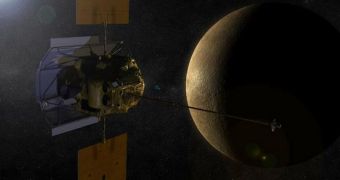Excitement is currently building up at NASA and in the international scientific community over the fact that the first long-term observations spacecraft is about to achieve orbital insertion around Mercury.
The innermost planet in our solar system is very little understood at this point, and experts hope that the space probe will provide them with the missing pieces to this exciting puzzle.
Anticipation is all the more difficult to bear considering that the MErcury Surface, Space ENvironment, GEochemistry and Ranging (MESSENGER) prove has been traveling through space for more than 6 years to get to this point.
It is currently scheduled to achieve orbital insertion around the planet on March 17. A long list of maneuvers must go hand in hand in order for this to happen, but mission controllers at NASA are convinced that the probe will pull through.
What MESSENGER needs to do is decelerate considerably from its current speed, and allow the planet's gravitational pull to take it over. The maneuver is called aerobreaking, and it uses Mercury's own atmosphere as a breaking system.
However, aerobreaking is a very complex maneuver, and mission controllers are on the edge of their seats, planning the engine firings so that everything goes smoothly. They spent 15 years developing the mission, and are not about to fail now.
“We are two days away from a new era in the exploration of one of our nearest neighbors. We are extremely excited,” said yesterday (March 15) in a conference Sean Solomon, quoted by Space.
He is the principal investigator of the MESSENGER mission, and is based at the Carnegie Institution of Washington. The spacecraft is managed by the Applied Physics Laboratory (APL) at the Johns Hopkins University (JHU), in Laurel, Maryland.
The spacecraft took $446 million to build, and was launched in August 2004. As time passed, it carried out no less than 6 flybys, one of Earth, two of Venus, and three of Mercury. All in all, it traveled more than 4.9 billion miles (7.9 billion kilometers) through the solar system.
According to experts at APL, the probe will start the orbital insertion maneuver at 8:45 pm EDT Thursday (0045 GMT March 18). Its main engine will be fired for about 15 minutes, which should decelerate MESSENGER sufficiently for it to be captured in Mercurial orbit.
“The team is practiced, ready to go, and the spacecraft is as well, and all the instruments,” explained APL MESSENGER mission operations manager Andrew Calloway. He says that the goal of the spacecraft is to spend at least one year mapping the planetary surface in detail.

 14 DAY TRIAL //
14 DAY TRIAL //